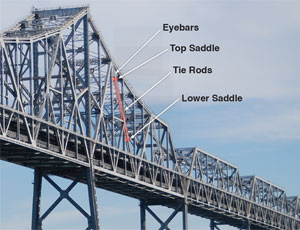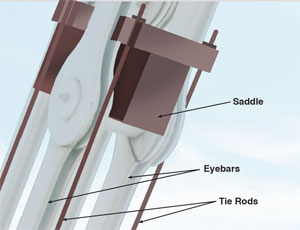For the second time in two months, crews are scrambling to install an emergency eyebar repair on the San Francisco-Oakland Bay Bridge. The original fix made over Labor Day weekend consisted of a steel saddle brace wrapping around a broken beam of the steel truss. That brace snapped during the windy Oct. 27 evening commute, dropping a 5,000-lb crossbeam and steel connectors into traffic and closing the bridge down indefinitely.


As of Oct. 28, crews with North Highlands, Calif.-based MCM Construction Inc. were dealing with high wind gusts of up to 50 mph as they worked carefully to remove debris and put the new steel in place. “We are reducing the capacity of the equipment because of the wind and that is slowing us down,” says Ed Puchi, MCM Construction treasurer. Winds were expected to calm down on Thursday.
The original fix was made after California Dept. of Transportation inspectors discovered a crack in the steel beam located in the cantilevered eastern span. They were conducting a routine inspection in conjunction with a weekend closure to install a 288-foot S-turn detour as part of the $6-billion reconstruction program. C.C. Myers, Rancho Cordova, Ca., the contractor on the detour project, surprised many by installing the brace in a separate emergency contract and reopening the bridge with only a 90-minute delay.
MCM was working on an unrelated contract to build the Oakland touchdown portion of the reconstruction. Puchi says his engineer happened to be on his way home near the scene of the failure when it occurred. Caltrans asked him to mobilize the MCM crew and cranes. Within hours, they had 20 people, welding gear, inspectors and rod tensioning specialists on site. “We just happened to be on site and answered the call,” Puchi says. “We will work out a contract later.”
The new design enhancements will focus on reducing vibration and therefore fatigue, says Caltrans spokesman Bart Ney. Based on the theory that vibrations from high winds caused the failure, Caltrans is putting the pieces back together with the addition of straps to hold the four new tie bars to the eyebar. “Tieing off the rods will ensure that if there is a failure, pieces won’t fall down,” Ney said.
Welds holding the bars in place were gouged out and new welds will be deeper, structural welds. Additionally, neoprene bearing pads may be used as dampeners to keep the bars from vibrating and causing fatigue to the tension bars. Caltrans ordered spherical ball and socket joints rather than flat bearings to spread the stress over a larger area. The replacement pieces have been fabricated in Sacramento and trucked to the site. Once the rods are in place, tensioning could take three hours and then the repair will be tested.
The Federal Highway Administration sent engineers to inspect the work and help determine the cause of the failure. “Metallurgists will inspect the cracked pieces to determine if fatigue was, indeed the problem,” Ney said. Dan Baker, C.C. Myers project manager, would not reveal the price of the contract, but said his company would not be fined for the failure because the design was approved by Caltrans.



Post a comment to this article
Report Abusive Comment